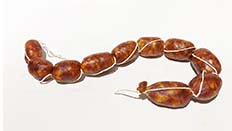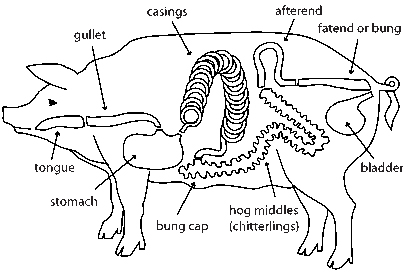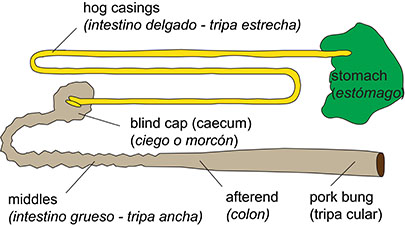Meats and Sausages
Casings and Linking Sausages
A casing is the container that holds a sausage. It can be natural or artificial, but for dry sausages the casing must be permeable what means that it must allow the moisture or smoke to go through. Sausages packed in artificial casing dry out faster as these casings are more permeable. Spanish sausages awarded Protected Designation of Origin (PDO) certificate must be stuffed into natural casings.
Dry sausages should be stuffed firmly to avoid air. Any pockets of air are invitations to bacteria as most bacteria need oxygen to survive. Even if the spoilage will not occur the little holes or discolorations will be visible in a sliced sausage. Stuffed sausages should be pricked with a needle to create an opening for the air to escape during drying. Sausages such as chorizo, salchichón, salchicha or butifarra are stuffed through a tube attached to a common manual grinder or through a separate manually cranked piston stuffer. Blood and liver sausages are soft and can be stuffed either with a stuffer or manually using a large funnel and a kitchen ladle. Large sausages such as head cheese, butelo, morcón, or any sausage stuffed into pork blind cap (caecum), stomach or bladder need to be manually stuffed on a case by case basis.
Linking sausages without using butcher twine by twisting filled casings is a common procedure, but Spanish sausages are generally linked with the twine as this method is more practical for drying sausages.
There are three popular arrangements for linking dry sausages:
Atados or ristra (atar means “tie up”, ristra means “string of elements”, for example string of garlic heads or beads). Sausage is stuffed into the full length of a casing so it becomes one continuous rope. Then it is tied off into individual sausage links about 15 cm (6”) long. After the first link is created, the twine is not cut, but continues to tie off the second link and so on until all links are connected together. Atados, ristra or sarta style sausages are shorter and of smaller diameter, making them easy to handle or separate. They end up on grills or in general cooking, for example in stews.
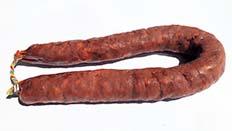
Herradura (horseshoe) or sarta - each sausage forms U- shaped loop. Herradura forms a longer loop whereas sarta is shaped more into a ring, like in morcillas. Butcher’s twine is clipped to both ends of the sausage forming a hanging loop 10-20 cm (4-8”) long. This method is used for 34-40 mm diameter sausages, for example chorizo.
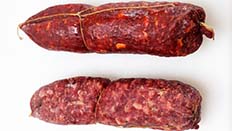
Cular - one straight section of round, but often irregular shape sausage due to individual properties of the casings. Pork or beef bungs are usually employed. This method is used for 38-50 mm diameter sausages or for stuffed loin.
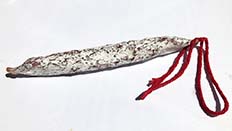
Vela - one straight section of the sausage, similar to “cular”, but smaller diameter around 30-40 mm and 40 cm (16”) long. The name is derived from candle (candle is vela in Spanish).
Pork bungs (cular or vela) are larger diameter and longer straight, sliced diagonally and eaten raw. They are the best choice for dry sausages having the right thickness and porosity for extended drying.
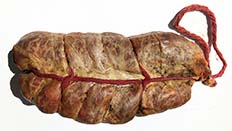
Pork blind caps (ciegos). In addition there are traditional products stuffed in irregular casings such as pork blind caps (caecum), pork stomachs, bladders or even wrapped in caul fat (fat membrane that looks like a net). Morcón sausage is always stuffed into blind cap as “morcón” is another name for this casing.
Spanish sausages are invariably linked or clipped with butcher twine of different colors, white, black, red, yellow or multicolored. There is no code or standard specifying what color of twine should be elected for different types of sausages. Meat plants use their own colors to distinguish different sausage types in order to avoid mix up and confusion.
A knowledgeable customer expects sausages to be packed in natural casings knowing that it usually is of a better quality than packed in synthetic casings mass produced products. Traditional production employs pork, beef and sheep casings with pork bungs having an excellent reputation for making dry sausages.
Note: Study by Roncalés et al. (1991) reported that sensory quality scores for fuet with natural casings were higher for almost all attributes except in cases of skin peeling which was scored higher for the fuet made with artificial casings.

